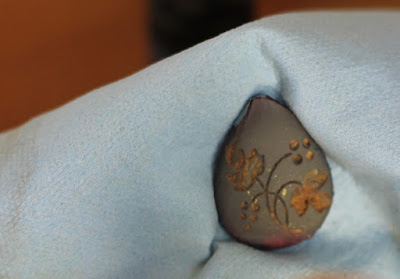First, the process is relatively simple, you apply a stencil to a product and then sandblast the stencil's image with a special abrasive applied at high pressure. The abrasive then erodes the surface in the open areas of the stencil and leaves a permanent carved impression.
 The very first step is the most important because it's where the creativity determines what the pendant will look like. I either draw the image I want or I use royalty-free graphics. I then upload the image to Photoshop where I darken it and scale it down to the size I like. Now it is ready to be printed on a special type of vellum paper shown below. To the left is my latest hand-drawn design "Transformation"
The very first step is the most important because it's where the creativity determines what the pendant will look like. I either draw the image I want or I use royalty-free graphics. I then upload the image to Photoshop where I darken it and scale it down to the size I like. Now it is ready to be printed on a special type of vellum paper shown below. To the left is my latest hand-drawn design "Transformation"Sidenote: Sandcarving or sandblasting using this process I am showing you has only been around for about 10 years.
My father is an electrician so together with my hubby we built a light box to expose the film.
The next step it to expose. I place the film on top of the vellum and turn the light on for 1min 30 seconds.


After exposing the next step is to pressure wash with warm water to develop the film. I use Ikonics Triggerjet and it works like a charm. You can buy washout boxes or just use a sink or shower.
I then place my stencil in my handy dandy Nesco food dehydrator. The alternative is using a photo resist film dryer or you can also use a blow dryer.
After drying I remove the carrier sheet and then apply to my stone of choice.
I love the creativity aspect of this step because every stone has different patterns and colors and I try to utilize the stones characteristics to enhance my designs.
I then position the film and remove the protective carrier sheet. I wrap the film around the stone and tape the back so the stone doesn't get damaged in the sandblasting process.


The next step is to sandblast the piece. I bought this equipment from a very nice gentleman who hand makes these out of Texas. We modified it to use a foot pedal so I had better control and installed a smaller more fine tuned tip for blasting.
Sorry about the pic being blurry, it was a challenge to get it just right.
I use silicon carbide grit which is an extremely fine sand and sandblast at approximately 35psi. I went through different grit, and different film until I got the exact formula that I use for my process.
The final step in the process is to airbrush paint the sandblasted piece. I use non toxic acrylic paint with metallic colors. I then can spray a coating of acrylic top coat to seal in the paint and to give it a shine.
I let the piece sit over night so it's nice and dry and then I remove the film and clean the stone.
Thank you for reading about my design process and please feel free to contact me if you have any questions.

























